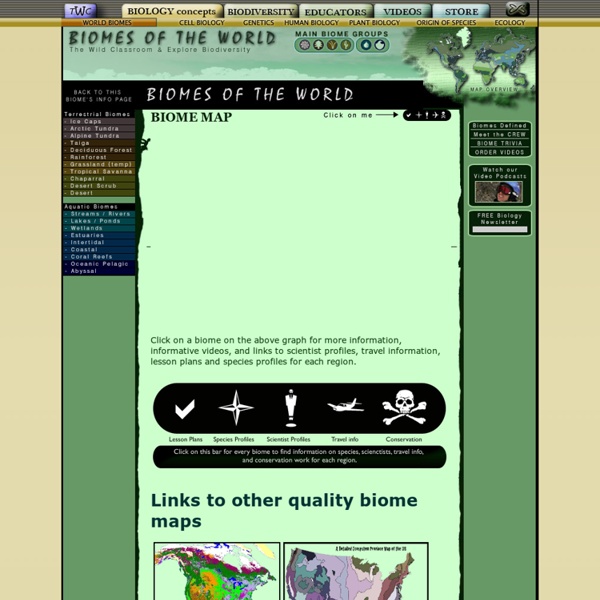



http://www.thewildclassroom.com/biomes/index.html
Related: EcologyKILL 'EM ALL They buzz. They bite. And they have killed more people than cancer, war, or heart disease. Zoom Rainforest Advertisement. EnchantedLearning.com is a user-supported site. As a bonus, site members have access to a banner-ad-free version of the site, with print-friendly pages.Click here to learn more. (Already a member? Earth Floor:Tundra Biome Arctic Tundra Arctic tundra is found across northern Alaska, Canada, and Siberia. This biome has long cold winters and short cool summers. The Arctic tundra has low precipitation (less than 10 inches per year) and dry winds. These conditions make the Arctic tundra a desert-like climate (see climograph).
A Zunal Biome Zoo You will be assigned into groups of five and be given one of the world biomes to conduct your research.In your groups you will assign the roles of specialists to break down the assignment. You will work individually on your specific specialist role and find the information relevant to produce your virtual tour. As a team you will work together to make a virtual tour of your biome through a PowerPoint presentation. You must include; *An introduction page that briefly describes your group and biome The Population Biology of Isle Royale Wolves and Moose: An Overview 1. Five decades of wolf-moose dynamics The wolves and moose of Isle Royale have been studied for more than five decades. Earth Floor: Rainforest Biome Tropical Rainforest The tropical rainforest is a hot, moist biome found near Earth's equator. The world's largest tropical rainforests are in South America, Africa, and Southeast Asia. Tropical rainforests receive from 60 to 160 inches of precipitation that is fairly evenly distributed throughout the year. The combination of constant warmth and abundant moisture makes the tropical rainforest a suitable environment for many plants and animals.
Tundra Biome The Tundra Biome In the tundra, conditions are cold, with an annual average temperature less than 5 C, and precipitation (mostly in the form of snow) less than 100 mm per year (see figure at right). The summer is brief, with temperatures above freezing lasting for only a few weeks at most. However, this "warm" summer coincides with periods of almost 24 hour daylight, so plant growth can be explosive. Bill Moyers Reports: Earth on Edge - Ecosystems Ecosystems are communities of interacting organisms and the physical environment in which they live. They are the combination and interaction of the plants, animals, minerals, and people in any given area of the Earth. A small bog, a single sand dune, or a tiny patch of forest is an ecosystem. But ecosystems are also forests covering thousands of kilometers, a major river system, a desert. Every centimeter of the planet is part of an ecosystem. Maybe the most familiar natural ecosystems are our backyards or parks near our home.
Using the Carbon Cycle Interactive Game in the Classroom - Windows to the Universe Have students read the Windows to the Universe page entitled The Carbon Cycle. Introduction: Ask students to (based of the reading) list the places where carbon is found on Earth. As a class, brainstorm why carbon is important and why carbon is sometimes hazardous. Tell students that for this online interactive game, they are all playing the role of carbon atoms. They will travel through the carbon cycle. Rainforest Biomes The tropical rain forest is a forest of tall trees in a region of year-round warmth. An average of 50 to 260 inches (125 to 660 cm.) of rain falls yearly. Rain forests belong to the tropical wet climate group. The temperature in a rain forest rarely gets higher than 93 °F (34 °C) or drops below 68 °F (20 °C); average humidity is between 77 and 88%; rainfall is often more than 100 inches a year. There is usually a brief season of less rain. In monsoonal areas, there is a real dry season.